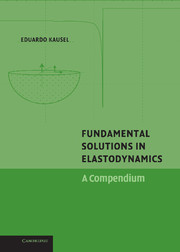Book contents
- Frontmatter
- Contents
- Preface
- SECTION I PRELIMINARIES
- SECTION II FULL SPACE PROBLEMS
- SECTION III HALF-SPACE PROBLEMS
- SECTION IV PLATES AND STRATA
- SECTION V ANALYTICAL AND NUMERICAL METHODS
- Read me first
- 8 Solution to the Helmholtz and wave equations
- 9 Integral transform method
- 10 Stiffness matrix method for layered media
- SECTION VI APPENDICES
9 - Integral transform method
Published online by Cambridge University Press: 12 January 2010
- Frontmatter
- Contents
- Preface
- SECTION I PRELIMINARIES
- SECTION II FULL SPACE PROBLEMS
- SECTION III HALF-SPACE PROBLEMS
- SECTION IV PLATES AND STRATA
- SECTION V ANALYTICAL AND NUMERICAL METHODS
- Read me first
- 8 Solution to the Helmholtz and wave equations
- 9 Integral transform method
- 10 Stiffness matrix method for layered media
- SECTION VI APPENDICES
Summary
The integral transform method provides the most general framework for the analytical and numerical treatment of elastodynamic problems in unbounded continua, provided that the media exhibit specific geometric and material regularities. In particular, it can be used to solve problems of sources in unbounded, homogeneous, and layered media formulated in Cartesian, cylindrical, or spherical coordinates. We provide a brief introduction to this method while picking up the fundamental tools needed for the powerful stiffness matrix method described in the next chapter, and we illustrate these concepts by means of various examples.
In a nutshell, the method consists in carrying out an appropriate integral transform on the vector wave equation – including the source term – which changes the problem from a set of partial differential equations in the space-time domain to a system of coupled linear equations in the frequency–wavenumber domain. After solving the latter for the displacements, an inverse integral transformation is applied, which returns the sought-after displacements (i.e., the wave field) in space–time.
In principle, the method is exact, but only in the simplest of problems (e.g., Pekeris's or Chao's problem) are the inverse transforms amenable to exact evaluation via contour integration. In most other (more complicated) cases, the inversion must be carried out numerically.
Cartesian coordinates
Consider a horizontally layered, laterally unbounded system subjected to a source (or body load) b acting at some location.
- Type
- Chapter
- Information
- Fundamental Solutions in ElastodynamicsA Compendium, pp. 125 - 139Publisher: Cambridge University PressPrint publication year: 2006



